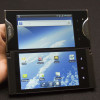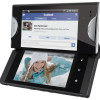Review: Kyocera Echo
The Echo uses a near-stock version of Android 2.2, with the notable addition of several features that specifically harness the two screens. Rather than look at the Android 2.2-specific stuff, we're going to focus on what makes the Echo unique with respect to its menu system.
Sprint claims the Echo works in four distinct modes: Single-Screen, Simul-Task, Optimized, and Tablet.
In Single Screen mode, the Echo behaves like any other bar-style Android handset; nothing new or fancy to report here.
In Simul-Task mode, the Echo supports two full applications running separately, one on each display. There are seven core applications that can work in this mode, including messaging, email, the browser, phone, photo gallery, contacts, and VueQue (more on that one later). This functionality is absolutely killer and is flat-out the best way to multitask on a phone.
Why? You can browse the web on one screen and watch a video on the other; you can compose an email on one screen and a text message on the other; you can scan through your photos and make a phone call on the other. That's real power. My favorite combination was browsing in one window with email running in the other. It truly works as well in reality as it does in theory. Awesome stuff.
In Optimized mode, the Echo runs a single application that has been significantly upgraded to work with the Echo's dual-screen set up. There are a limited number of apps that support this mode at launch, though Kyocera is offering special software tools that third-party developers need to optimize their apps for the Echo.
Here's the crux of how Optimized Mode works: Let's say you're composing an email. The email text will fill the top screen, and a software QWERTY keyboard will fill the bottom screen. Or, let's say you're watching YouTube videos. You can watch a video in one display, and scan through YouTube on the other screen for more videos to watch. You can also do things such as run two separate browser tabs that are both visible at the same time. Given the possibilities that two screens presents, I really can't wait to see what developers do to optimize their apps for this dual-screen experience. The potential is unlimited.
Tablet mode is how most apps will act on the Echo. They'll simply stretch across the full 4.7-inch display without any specific new features that take advantage of what the Echo offers. As long as you don't mind the black bar running down the middle of the app, it offers a huge amount of screen space. It's an ideal way to look at certain apps, such as Google Maps, your photos, large web pages, and so on. Having such a large amount of real estate is really cool when you want to be able to see the bigger picture.
What's it like to transition between all these modes? Well, Single Screen mode is obvious. Simply open it up and it automatically converts to Tablet mode (whether the Echo is flat or not). As mentioned, only specific apps are customized for Optimized and Simul-Task modes. The Simul-Task apps can be launched by tapping both screens at the same time. This brings up the list of apps that can function in Simul-Task. Select the ones you want and bingo, there you go.
Apart from these different modes of operation, the Echo's base Android 2.2 software will be familiar to anyone who's used an Android handset before.
In terms of system performance, I experienced several hard crashes that required a battery pull, and the system stuttered a few times, but it wasn't terrible. Most of the time, it performed quickly and smoothly.


 Hands-On: Kyocera Echo
Hands-On: Kyocera Echo
 Kyocera Echo Sports Two Displays, Hinged Design
Kyocera Echo Sports Two Displays, Hinged Design
 Kyocera Echo
Kyocera Echo



